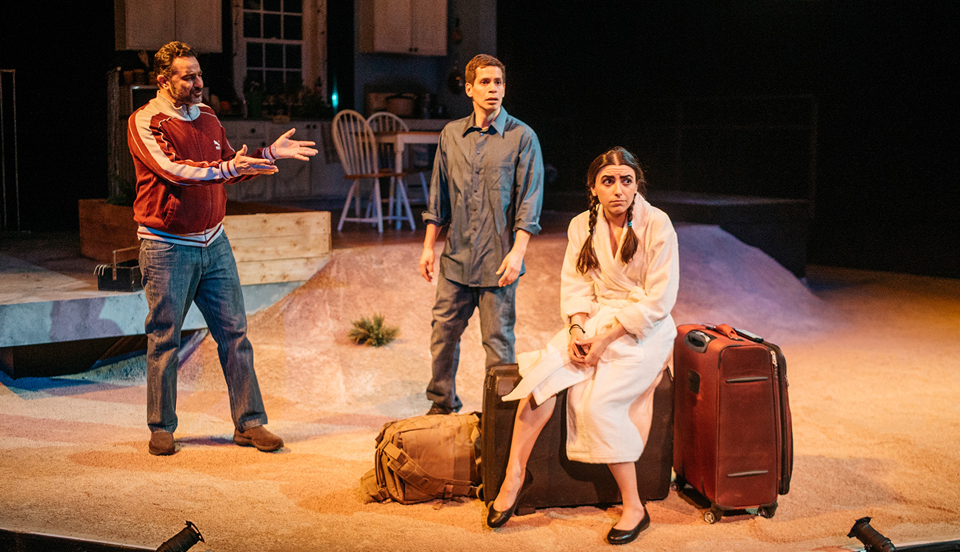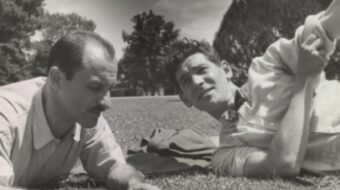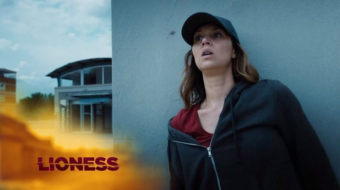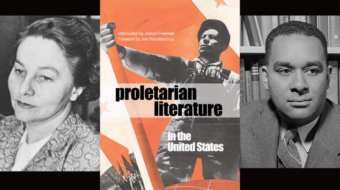
LOS ANGELES—The California premiere of The Happiest Song Plays Last took place February 22 at downtown’s L.A. Theatre Center in a well appointed, masterful production by the Latino Theatre Company. Graced with the live sounds of traditional Puerto Rican folk music performed by Puerto Rican Grammy-nominated tres and cuatro player and singer Nelson González, this emotionally rich play is the final installment in Quiara Alegría Hudes’ three-play “Elliot cycle.”
The trilogy is now completing its first-ever run of all three plays in one city at one time. It began with the Pulitzer Prize-finalist Elliot, A Soldier’s Fugue at the Kirk Douglas Theatre, continued with the Pulitzer Prize-winner Water by the Spoonful at the Mark Taper Forum, and concludes with The Happiest Song Plays Last. The three related plays, which can also be appreciated as stand-alone works, center around Elliot, a Philadelphia-born young man of Puerto Rican background. In three stages of his life over a period ranging from the early days of the Iraq War to more or less the recent present, he intersects with a very wide range of characters in many different places, some of them, such as his dear cousin Yazmin, as well as references to cherished family members, recurring from play to play.
One of the distinguishing features of Water by the Spoonful is its overlapping of at least two separate worlds in which Elliot is at least marginally a part. For a long time it is hard for an audience to appreciate what one world has to do with the other. Especially considering the back-and-forth measure of time and space that Hudes employs, it requires considerable effort on the audience’s part to ingest all the information we are given and to reassemble it in a semblance of order. I visualized the playwright’s intersecting circles as a moving Venn diagram with the two large circles gradually moving together to create a shared middle space.
She uses a similar technique in Happiest: vignettes of life in disparate places such as Arizona, Philadelphia and Jordan (with a side trip to Cairo’s Tahrir Square in the middle of 2011’s Arab Spring), that are seemingly unconnected. The Venn diagram metaphor could still be applied, but then another image came to mind: Hudes is laying out a collection of jigsaw puzzle pieces, in temporal and spatial disarray, and insisting it’s our job to put them together to make a recognizable picture. To my surprise, not long after this image occurred me, a character in the play uses the words “jigsaw puzzle” and I knew I was on course.
This final play of the trilogy traces a parallel year in the lives of two cousins and best friends, Elliot (Peter Pasco) and Yazmin (Elisa Bocanegra). Each in their own way is trying to be a decent positive force in the world—she by inheriting her mother Ginny’s role as a natural community organizer and neighborhood “mom” with an open door and plenty of good wholesome food always on the stove; and he, following in his parents’ and grandfather’s footsteps, in military service. Of course, this is theatre, so yes, they’ve both made their share of mistakes and misjudgments along the way.
We left Water by the Spoonful hanging with the prospect of Elliot, with his Marine Corps experience in Iraq, advising on an indy film about that war and its survivors. Now we find him in Jordan, where the film is being shot, as the unexpected action-film hero, which causes all his old PTSD from the war to rise to the surface. One of the film’s locally hired aides is Ali (Kamal Marayati), a genial Iraqi refugee in Jordan and former member of the Iraqi armed forces—in other words, the kind of soldier whose units the George W. Bush administration in its infinitely imbecilic wisdom decided to completely disband for fear there might be Saddam Hussein loyalists among them. And that’s how we got civil war in Iraq, folks! Power vacuum! And it worked so well in Libya and Syria, too!
Also in Jordan working on the film is Shar (Vaneh Assadourian), a Juilliard School graduate from a privileged multiracial background who has found work as a stunt actor. She completes the cast of characters in that circle.
Back home in North Philadelphia, Yazmin is organizing pro-immigrant demonstrations, showing solidarity between Puerto Ricans and Mexicans (that’s where the Arizona scene comes in), and watching over her neighbors like a mama hen. Her special charge is the young mentally challenged man Lefty (John Seda-Pitre), who despite his limitations is also trying hard to serve his community as a caring school traffic officer. Rounding out this circle’s cast is Agustín (Al Rodrigo), a high school teacher and longtime expert performer of Puerto Rican music on the tres, cuatro and standard guitar, who has guided many a young person toward a fulfilling life of music. Back in the day, when Elliot was five years old, Augustín briefly started teaching music to him.
The guitar player Nelson González is an important, though tangential part of the action, sauntering onto the stage with his appropriately themed songs, then wandering off. Wonderful an addition to the proceedings as he is, his lyrics are not translated, which sets up an unfortunate barrier between the stage and the non-Spanish-speaking audience. With my Spanish I was able to discern the honor paid to “the people that sings, that loves, the people that takes to the streets” and in the finale, “No one knows what he has until he loses it.” But there was much music in between, including a lot of romantic ballads, that I enjoyed listening to but was unable to understand. Interestingly, González has performed this part in all three previous productions of the play, in Connecticut, New York and Chicago.
Many of Agustín’s stories also involve a deep commitment to popular struggles. He recounts the tradition of song in Puerto Rico as the “newspaper” of his day, musicians and poets spontaneously singing out their artistic interpretations of current events.
Also of interest is the director, Edward Torres, whose long involvement with the Elliot project includes acting in the first play, Elliot: A Soldier’s Fugue, directing Water by the Spoonful in San Diego in its California premiere, then directing the Happiest world premiere in Chicago.
The creative team for The Happiest Song Plays Last includes set designer Se Hyun Oh, who came up with an ingenious unit that spatially delineates the Jordanian desert and Yazmin’s cozy kitchen; lighting designer John A Garofalo; sound designer Ivan Robles; projections designer Yee Eun Nam, who incorporated scenes from the 2017 hurricanes in Puerto Rico; and costume designer Dianne K. Graebner. This is theatre production on a high, if overall modest level.
Playwright Hudes is working in an era that has all but deconstructed the linear play, and it might be interesting to speculate why this is so—our busily multitasking population, our short attention span, our explosion of news and entertainment platforms, exhaustion with the predictability of the classic “well made play?” No doubt some part is played by all of these factors.
If in Water by the Spoonful I had the sense that Hudes was trying to make us work to fit the moving parts together, I also felt the effort paid off. In Happiest, which serves as a kind of summing up of the trilogy—though also written to work independently—I left not one hundred percent convinced that the jigsaw pieces come together, or even if they all came in the box. (This one didn’t receive a Pulitzer nomination, for what that’s worth.) An undercurrent in the play is the network of rivers and streams, mostly now covered by concrete, in the city of Philadelphia. With all the characters’ baroque criss-crossing lives to focus on, I simply found these subterranean waterways too much information, too removed from the personal stories except on the most symbolic plane, and I couldn’t invest any more of my brain’s energy into it. I wonder if in her drive to pile up and mix up the narrative so erratically she became overwhelmed by her own artistic license.
Hudes has to resort to a moment of afterlife magical realism to evoke a contented eternity of lovely Puerto Rican communal music-making for these troubled characters, which seems far from an inevitable conclusion. In fact, I’d go so far as to say that though she has gone on to other plays, other subjects, other characters, if she ever cared to, there is still a future in the further adventures of Elliot and company. My own view, however, is that it’s well enough that she’s done with them, releasing these characters to continue living on the stage.
There are, however, many moments of satisfaction in the play—an impressive monologue by Yazmin on the fatal inadequacies of our medical care establishment; Lefty’s reaction to the death of a young student and the fate of the memorial created for her; Ali’s letter recounting to Elliot what happened when Ali’s cousin in Iraq tried to return a man’s Iraqi passport that Elliot brought back home; Elliot’s bouts with PTSD and his sincere efforts at healing from the criminality of his deeds in Iraq as he courageously strives to embrace his humanity (this attempt at a personal Truth and Reconciliation being itself so rare when it comes to the standard, unthinking “thank you for your service” way so many Americans have come to regard our military); Agustín’s poignant musical stories; a gently playful midlife seduction scene complete with a red thong; and of course, the music itself.
The Latino Theater Company production of The Happiest Song Plays Last is performed through March 19 on Fri. and Sat. at 8 pm, Sun. at 3 pm, and Mon. at 7:30 pm at the Los Angeles Theatre Center, 514 S. Spring St., Los Angeles 90013. To purchase tickets, call (866) 811-4111 or go to http://thelatc.org/.










